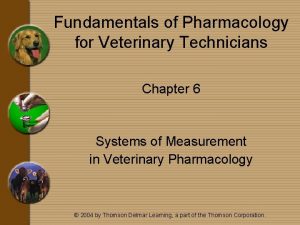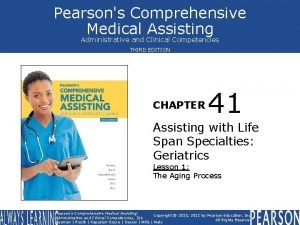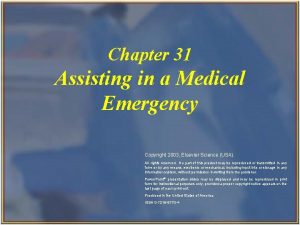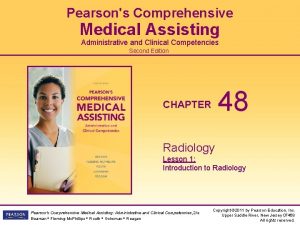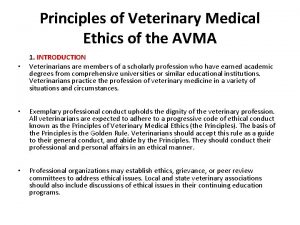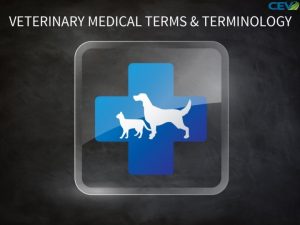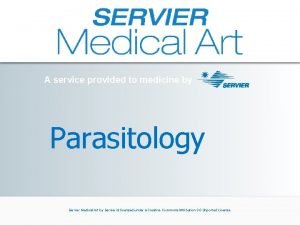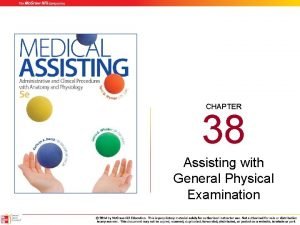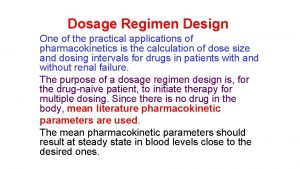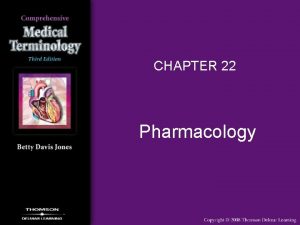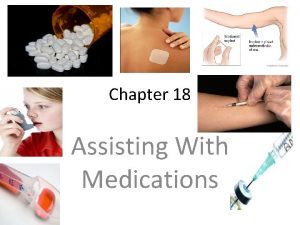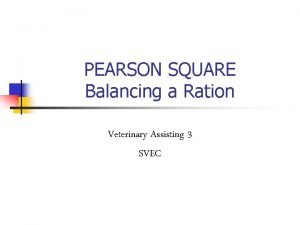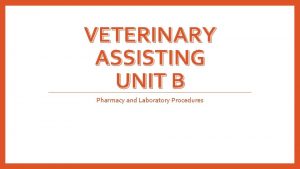Pharmacology Assisting Veterinary Medical Applications What is Pharmacology



























- Slides: 27

Pharmacology Assisting Veterinary Medical Applications

What is “Pharmacology”? • The branch of veterinary medicine concerned with the uses, effects, and administration of drugs. • The study of drugs.

Identifying Medications To identify medications in the veterinary clinic you must first identify the following: Classification of drug Form of drug Route of administration Method of administration

Classifications of Drugs • What is a drug classification? – Characterized by a drug’s action(s) in the body or on target tissues.

Classifications of Drugs Emetics- drugs used to induce vomiting Antiemetics- drugs that relieve vomiting Antidiarrheal agents- drugs used to lessen diarrhea Cathartics- drugs that increase bowel motility or loosen stools

Classifications of Drugs Antacids- drugs that counteract stomach acid Diuretics- drugs that increase the production of urine Antibiotics- drugs that kill/inhibit growth of bacteria Anti-inflammatories- drugs that reduce inflammation

Classifications of Drugs Analgesics-drugs that relieve pain and raise the pain threshold Anesthetics- drugs that decreases feeling sensation; numbing Anticonvulsants-drugs that inhibit seizures Stimulants-drugs that excite the functional activity of an organ – Tranquilizers- drugs that sedate/quiet an anxious patient

Forms of Drugs • What is a form? – Characterized by a drug’s physical composition or state such as: – Solid tablet, syrup, lotion, ointment, injectable, extract, etc…

Forms of Drugs Solid- include tablets, gel capsules & coated tablets Solution- a drug that is dissolved in a liquid and will not settle if left sitting; syrups and elixirs Suspension- a drug that is suspended but not dissolved in the liquid. The particles will settle and must be shaken before administered Extract- agent composed of prepared plant/animal parts rather than manufactured chemicals

Forms of Drugs Topical- drugs that are liquid at room temperature and applied to the surface of the skin; include liniments and lotions Semisolid- drugs that are semisolid in state at room temperature and applied to the skin; include ointments and pastes. Injectable- drugs that are administered via a needle and syringe

Routes of Drug Administration What does “route of administration” mean? -the pathway a drug enters the body. – Amount of drug that reaches the target tissue can be significantly altered if the proper route is not used. – Each route has its own pattern (speed/degree) of drug absorption.

Routes of Drug Administration Intravenous- (IV) injection into the vein Intramuscular- (IM) injection into the muscle Subcutaneous- (Sub-Q, SC) injection below the skin Intradermal- application through the skin Oral- given by mouth for digestive absorption Inhalation- administration of aerosol, mist or gas for respiratory absorption

Methods of Drug Administration What are methods of administration? -The techniques used to give the drug to the patient.

Methods of Drug Administration 1. Injection administration (given by a shot) 2. Oral administration (given by mouth) 3. Topical administration (applied to surface of skin) 4. Aerosol administration (mist or gas for respiratory tract)

It’s the law! Controlled Substances – a substance that has the potential for physical addiction, physiologic addiction and/or abuse. Controlled Substances Act of 1970 - a practitioner who has controlled substances stored in his/her office must keep these drugs in a securely locked, substantially constructed cabinet or safe.

Schedules of Controlled Substances C-I—No medical value, greatest restrictions; e. g. , LSD, heroin + C-IV— low potential for abuse, may lead to limited dependence; includes valium C-V— subject to state/local regulation, low abuse potential; least restrictions abuse potential C-II—highly addictive; e. g. , opium, morphine C-III— some potential for abuse, less than C-II; e. g. , ketamine

Controlled Substances ü Kept in a locked, sturdy storage cabinet. ü Log must be kept of any controlled drug that was used. ü Records must state: date, purpose and amount. ü Records must include receipts of purchase and sale of drugs. ü Log must be kept for at least 2 years.

Equipment used in the pharmacy Pill Counter Pill Cutter

Equipment used to Administer Medications Tools used to administer solid pills, capsules and caplets Pet Piller Balling gun

Using a Pet Piller

Equipment used to Administer Medications Syringes Used to administer liquids to a patient – Disposable: to be disposed of after one use – Automatic/ Re-usable: to be used many times

Syringes -Identified by capacity (cc) -larger cc syringes hold larger amounts of liquid

Equipment used to Administer Medications Needle Sizes come in various lengths. – Sizes come in gauges 4 -30. – The larger the gauge #, the smaller the needle. *Remember to dispose of properly in sharps container*

Equipment used to Administer Medications Notice how the smallest needle has the largest gauge #.

Needles Disposable needles may be identified by their color code. Needle Lengths (mm) Needle Diameter (mm) Color Code Gauge WHITE 16 G 38 1. 6 PINK 18 G 38 1. 2 CREAM 19 G 38 1. 1 YELLOW 20 G 25, 32, 38 0. 9 GREEN 21 G 25, 32, 38 0. 8 BLACK 22 G 25, 32, 38 0. 7 BLUE 23 G 25, 32, 38 0. 6 PURPLE 24 G 25, 32, 38 0. 55 ORANGE 25 G 25, 32, 38 0. 5 BROWN 26 G 13, 38 0. 45 LIGHT GREY 27 G 19, 38 0. 4

TEKS: 130. 6 Veterinary Medical Applications • (15) The student identifies pharmacology-assisting procedures, skills, and objectives that are included in the job description of an animal care assistant. The student is expected to: A. identify medications according to their classification, form, routes, and methods of administration; B. explain handling and distribution, protocol, and laws for controlled substances; C. calculate dosage using factors such as concentration of drug, weight of animal, and required dosage; D. complete a prescription label with identifiers that are required by the United States Food and Drug Administration; and E. select equipment and instruments used to give medications.

Veterinary Pharmacology A product of the Partnership for Environmental Education and Rural Health at College of Veterinary Medicine & Biomedical Sciences, Texas A&M University Funding support from the National Center for Research Resources, National Institutes of Health
 Fundamentals of pharmacology for veterinary technicians
Fundamentals of pharmacology for veterinary technicians Pearson's comprehensive medical assisting
Pearson's comprehensive medical assisting Chapter 42 assisting in other medical specialties
Chapter 42 assisting in other medical specialties Chapter 42 assisting in other medical specialties
Chapter 42 assisting in other medical specialties Chapter 31 assisting in a medical emergency
Chapter 31 assisting in a medical emergency Pearson's comprehensive medical assisting
Pearson's comprehensive medical assisting Medical assistant program rop
Medical assistant program rop Avma principles of veterinary medical ethics
Avma principles of veterinary medical ethics Common veterinary medical equipment vocabulary
Common veterinary medical equipment vocabulary Brig ajit millu
Brig ajit millu Queening medical definition
Queening medical definition Servier medical art veterinary
Servier medical art veterinary Guest departure meaning
Guest departure meaning Assisting in microbiology and immunology
Assisting in microbiology and immunology Inspection auscultation percussion palpation
Inspection auscultation percussion palpation Chapter 41 assisting in geriatrics
Chapter 41 assisting in geriatrics What is the noun form of advertise
What is the noun form of advertise Chapter 6 dental assisting
Chapter 6 dental assisting What credential is issued by the danb
What credential is issued by the danb Chapter 5 assisting with the nursing process
Chapter 5 assisting with the nursing process Cartersville medical center medical records
Cartersville medical center medical records Gbmc medical records
Gbmc medical records Hepburn osteometric board
Hepburn osteometric board Torrance memorial hospital medical records
Torrance memorial hospital medical records Ptal california medical board
Ptal california medical board Bioavailability def
Bioavailability def Loading dose
Loading dose Advantages and disadvantages of drugs
Advantages and disadvantages of drugs
